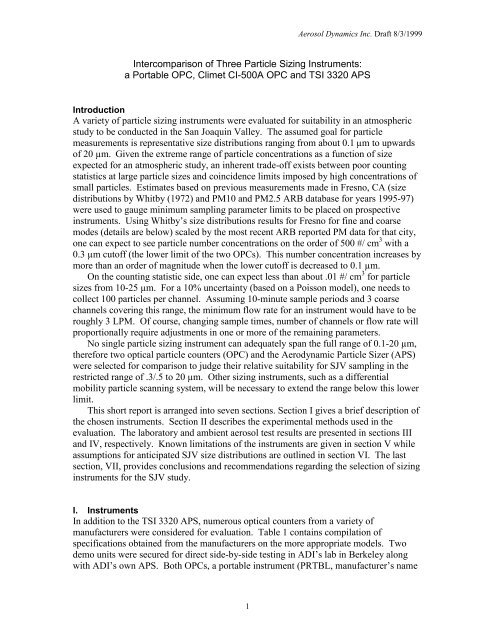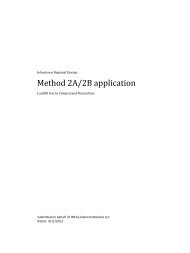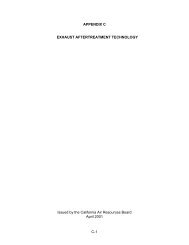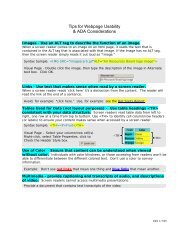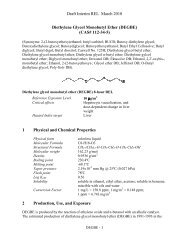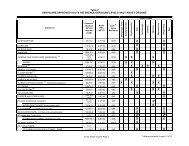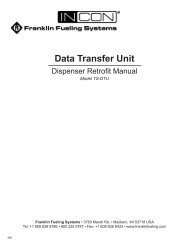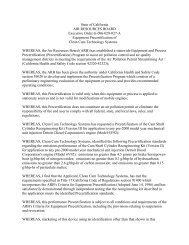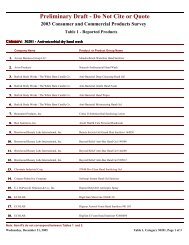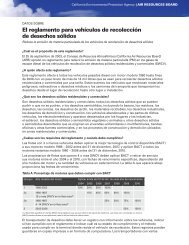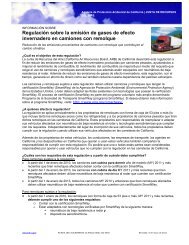Table of Contents - California Air Resources Board
Table of Contents - California Air Resources Board
Table of Contents - California Air Resources Board
Create successful ePaper yourself
Turn your PDF publications into a flip-book with our unique Google optimized e-Paper software.
1<br />
Aerosol Dynamics Inc. Draft 8/3/1999<br />
Intercomparison <strong>of</strong> Three Particle Sizing Instruments:<br />
a Portable OPC, Climet CI-500A OPC and TSI 3320 APS<br />
Introduction<br />
A variety <strong>of</strong> particle sizing instruments were evaluated for suitability in an atmospheric<br />
study to be conducted in the San Joaquin Valley. The assumed goal for particle<br />
measurements is representative size distributions ranging from about 0.1 µm to upwards<br />
<strong>of</strong> 20 µm. Given the extreme range <strong>of</strong> particle concentrations as a function <strong>of</strong> size<br />
expected for an atmospheric study, an inherent trade-<strong>of</strong>f exists between poor counting<br />
statistics at large particle sizes and coincidence limits imposed by high concentrations <strong>of</strong><br />
small particles. Estimates based on previous measurements made in Fresno, CA (size<br />
distributions by Whitby (1972) and PM10 and PM2.5 ARB database for years 1995-97)<br />
were used to gauge minimum sampling parameter limits to be placed on prospective<br />
instruments. Using Whitby’s size distributions results for Fresno for fine and coarse<br />
modes (details are below) scaled by the most recent ARB reported PM data for that city,<br />
one can expect to see particle number concentrations on the order <strong>of</strong> 500 #/ cm 3 with a<br />
0.3 µm cut<strong>of</strong>f (the lower limit <strong>of</strong> the two OPCs). This number concentration increases by<br />
more than an order <strong>of</strong> magnitude when the lower cut<strong>of</strong>f is decreased to 0.1 µm.<br />
On the counting statistic side, one can expect less than about .01 #/ cm 3 for particle<br />
sizes from 10-25 µm. For a 10% uncertainty (based on a Poisson model), one needs to<br />
collect 100 particles per channel. Assuming 10-minute sample periods and 3 coarse<br />
channels covering this range, the minimum flow rate for an instrument would have to be<br />
roughly 3 LPM. Of course, changing sample times, number <strong>of</strong> channels or flow rate will<br />
proportionally require adjustments in one or more <strong>of</strong> the remaining parameters.<br />
No single particle sizing instrument can adequately span the full range <strong>of</strong> 0.1-20 µm,<br />
therefore two optical particle counters (OPC) and the Aerodynamic Particle Sizer (APS)<br />
were selected for comparison to judge their relative suitability for SJV sampling in the<br />
restricted range <strong>of</strong> .3/.5 to 20 µm. Other sizing instruments, such as a differential<br />
mobility particle scanning system, will be necessary to extend the range below this lower<br />
limit.<br />
This short report is arranged into seven sections. Section I gives a brief description <strong>of</strong><br />
the chosen instruments. Section II describes the experimental methods used in the<br />
evaluation. The laboratory and ambient aerosol test results are presented in sections III<br />
and IV, respectively. Known limitations <strong>of</strong> the instruments are given in section V while<br />
assumptions for anticipated SJV size distributions are outlined in section VI. The last<br />
section, VII, provides conclusions and recommendations regarding the selection <strong>of</strong> sizing<br />
instruments for the SJV study.<br />
I. Instruments<br />
In addition to the TSI 3320 APS, numerous optical counters from a variety <strong>of</strong><br />
manufacturers were considered for evaluation. <strong>Table</strong> 1 contains compilation <strong>of</strong><br />
specifications obtained from the manufacturers on the more appropriate models. Two<br />
demo units were secured for direct side-by-side testing in ADI’s lab in Berkeley along<br />
with ADI’s own APS. Both OPCs, a portable instrument (PRTBL, manufacturer’s name


